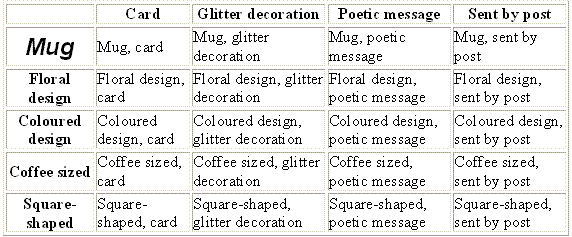Heuristic Ideation is a very efficient group technique
that helps to generate new and innovative ideas. The participants compare
two items or concepts that are not apparently related, in order to stimulate
idea generation.
Hereunder you find the technique procedure:
Example 1
1. Choose two items of interest that are already in existence but are
not apparently connected.
A businessman selects a Chinese mug and a greetings card among his products;
2. Make a list of “components” for each selected item.
The mug “components” may correspond to: square-shaped, floral design, coffee sized..;
The greeting card “components” may correspond to: poetic message, to be sent by post, glitter decoration...;
3. Set up a matrix where the rows list the components
of the one product and the columns list the components of the other,
and each cell corresponds to a combination of two “components”
from different products (see Figure 3-7)

Figure 3-7 “Components” crossing matrix (Source: http://www.mycoted.com)
4. Cross out any matrix cells that correspond to existing products.
“Floral design, card”;
5. Identify any cells with a natural market potential.
“Mug, sent by post”;
6. Looking at the matrix from another angle, try to identify any cells that look creative thought provoking;
7. Develop cells 5 and 6 into workable ideas.
Elspeth McFadzean (2002) includes heuristic ideation
among paradigm stretching techniques; they promote idea generation through
forced associations and inputs that are not apparently connected.
[Source: www.mycoted.com]
-
McFadzean E., Developing and Supporting Creative Problem-Solving Teams: Part 1 - a Conceptual Model, Management Decision, Vol. 40, n. 5, 2002, pp. 463-475.